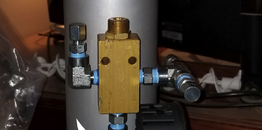phgachoud
Registered
No offense taken, had a great time reading the docs and RTFM was really not enough, any other documentation will be most welcome! am wondering though about the PMV as I dont have yet the compressor in front of me what is the adjustement procedure. The img is quite laconic for my understanding.Inline detectors detect moisture content if that's the disk you have installed (although I think it's better to just track your filter life than rely on those).
Your best bet is to familiarize yourself with this document and all the abbreviations and why things are in line where they are (it does not have an in line detector or "site glass"). Then apply it to your compressor and see what it has and what it doesn't have. Maybe it needs some things, maybe it doesn't, but you should have a good understanding what all the parts do.
Compressor Filter System Theory - Scuba Engineer
High Pressure Breathing Air Compressor Filtration System Design author:- Stephen E Burton BSc(hons) C.Eng, MIET - Email to:- scubaengineer@gmail.comscubaengineer.com
No offense, but it's obvious you haven't done a ton of research. Not at all knocking you for it, we all have to start somewhere, but your best bet is learn as MUCH as you can on how the compressor works and then start asking questions.
Thx a ton guys!




